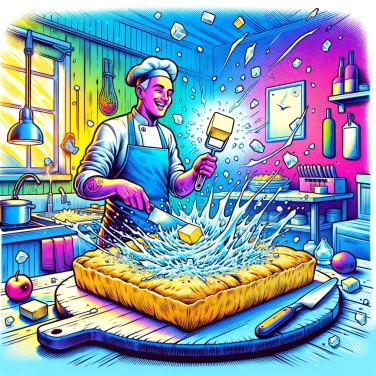Chilling the butter before working it into a puff pastry ensures a better texture because it helps maintain distinct layers of butter and dough, ensuring optimal flakiness.

Using cold butter when preparing puff pastry makes it easier to create thin and even layers. When the butter is well-chilled, it remains solid and does not directly mix with the dough, instead forming distinct layers. As a result, each roll creates alternations of butter and dough, similar to stacked sheets. These distinct layers are precisely the secret to a light and airy pastry after baking. The firmer and colder the butter, the more these layers stay separate and defined throughout the rolling process.
Cold butter is significantly less sticky and softer, which clearly makes working with the dough easier. Being cold, it remains firm, allowing the layers of dough to stay distinct during rolling. As a result, the dough is easier to stretch and fold, without the butter oozing out everywhere. It also prevents tearing or smudging, resulting in a homogeneous, smooth, and even dough. In contrast, butter that is too soft makes the dough difficult to handle, sticky, and really tedious to roll out neatly.
Using cooled butter allows for precise control over when the fat will melt during cooking. Cold butter delays its melting in the oven, giving the dough time to bake and allowing the layers of dough to be properly formed before the butter actually begins to melt. If the butter melts too early due to a temperature that is too high while working, you end up with a greasy, dense, and soft dough, far from the desired flaky dough. In contrast, cold butter will release its steam at the right moment, perfectly puffing the layers of dough before being absorbed, resulting in a light, airy, and pleasant texture in the mouth.
Working with very cold butter allows for the creation of distinct layers that effectively trap steam during cooking. The water trapped between the layers expands under heat, forming numerous small bubbles called alveoli, which gives that light and airy texture. The result: a dough that rises better and has a nice flaky texture. Additionally, since the thin layers expand separately without fusing, the surface of the dough remains dry; this essential detail makes the final result pleasantly crispy. In contrast, dough made with soft butter will yield a denser product, coarsely aerated, and softened instead of the desired crispness.
During resting phases, keep the dough in the refrigerator (around 4°C) to maintain the firmness of the butter and ensure ease of rolling, thereby promoting an optimal flaky texture after baking.
It is preferable to chill the butter in the refrigerator for at least 30 minutes to 1 hour so that it is firm and easy to handle when rolling out. Butter that is too soft will lose its ability to create distinct layers.
This may be due to butter that was not cold enough during preparation. Cold butter prevents it from mixing into the dough and allows for a clear separation of layers during baking, which explains why butter that is too soft compromises this aspect.
Yes, margarine can eventually replace butter, especially for economic or dietary reasons. However, special puff pastry margarine is often recommended because it is specifically formulated to withstand high temperatures and maintain the distinct layers of puff pastry.
It is strongly advised against using butter at room temperature, as this complicates the creation of distinct layers, resulting in a less flaky and less crispy texture when baked.

0% of respondents passed this quiz completely!
Question 1/5